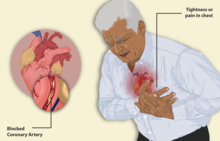Unstable angina
| Unstable angina | |
|---|---|
| Other names | Crescendo angina |
 | |
| Illustration depicting angina | |
| Specialty | Cardiology |
| Symptoms | Chest pain or chest discomfort at rest or minimal exertion, or a new onset chest pain or discomfort on exertion. |
| Complications | Coronary artery disease |
Unstable angina is a type of
It can be difficult to distinguish unstable angina from
Signs and symptoms
Symptoms of unstable angina are the same as those of
The
Pathophysiology
The pathophysiology of unstable angina is controversial. Previously, unstable angina was assumed to be angina pectoris caused by disruption of an atherosclerotic plaque with partial thrombosis and possibly embolization or vasospasm leading to myocardial ischemia.[9][10] However, sensitive troponin assays reveal rise of cardiac troponin in the bloodstream with episodes of even mild myocardial ischemia.[11] Since unstable angina is assumed to occur in the setting of acute myocardial ischemia without troponin release, the concept of unstable angina is being questioned with some calling for retiring the term altogether.[12]
Diagnosis
Unstable angina is characterized by at least one of the following:
- Occurs at rest or minimal exertion and usually lasts more than 20 minutes (if nitroglycerinis not administered)
- Being severe (at least Canadian Cardiovascular Society Classification 3) and of new onset (i.e. within 1 month)
- Occurs with a crescendo pattern (brought on by less activity, more severe, more prolonged or increased frequency than previously).[13][14][15]
Fifty percent of people with unstable angina will have evidence of
Management
Nitroglycerin can be used immediately to dilate the venous system and reduce the circulating blood volume, therefore reducing the work and oxygen demand of the heart.[17][18] In addition, nitroglycerin causes peripheral venous and artery dilation reducing cardiac preload and afterload. These reductions allow for decreased stress on the heart and therefore lower the oxygen demand of the heart's muscle cells.[19]
See also
References
- PMID 10631280.
- ^ "unstable angina" at Dorland's Medical Dictionary
- PMID 15317439.
- ^ PMID 32860058.
Unstable angina is defined as myocardial ischaemia at rest or on minimal exertion in the absence of acute cardiomyocyte injury/necrosis. [...] Compared with NSTEMI patients, individuals with unstable angina do not experience acute cardiomyocyte injury/necrosis.
- ^ PMID 34709879.
- PMID 32860030.
NSTEMI is characterized by ischaemic symptoms associated with acute cardiomyocyte injury (=rise and/or fall in cardiac troponin T/I), while ischaemic symptoms at rest (or minimal effort) in the absence of acute cardiomyocyte injury define unstable angina. This translates into an increased risk of death in NSTEMI patients, while unstable angina patients are at relatively low short-term risk of death.
- ^ a b "Acute Coronary Syndromes (Heart Attack; Myocardial Infarction; Unstable Angina) - Heart and Blood Vessel Disorders". MSD Manual Consumer Version. Retrieved 2023-02-12.
- ^ "Unstable Angina". www.heart.org. American Heart Association. Archived from the original on 2023-03-15. Retrieved 2023-05-05.
- ^ Robbins (2005). Pathologic Basis of Disease (7th ed.).
- PMID 9826306.
- PMID 18997177.
- PMID 23775194.
- PMID 1225338.
- PMID 12356647.
- ^ a b Libby: Braunwald's Heart Disease: A Textbook of Cardiovascular Medicine
- S2CID 32268852.
- PMC 5901592.
- ISBN 978-0-471-89980-8.
- PMID 26316714.
- PMID 1225338.
